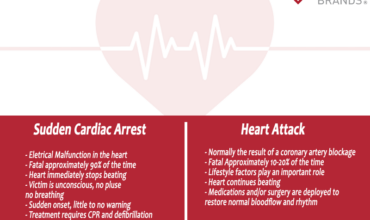- Your cart is empty
- Continue Shopping


Roofing is one of the most physically demanding and high-risk professions in the construction industry. Between extreme heat exposure, intense physical labor, and the inherent dangers of working at heights, roofers face unique health and safety challenges every day. While hard hats, harnesses, and safety protocols are standard equipment, there’s one critical piece of life-saving technology that many roofing companies overlook: the Automated External Defibrillator (AED).
Roofing crews work in conditions that significantly increase the risk of sudden cardiac arrest (SCA). The combination of extreme temperatures, strenuous physical exertion, and dehydration creates a perfect storm for cardiac events. According to safety experts, workplaces with high physical demands or high-stress levels make employees even more susceptible to sudden cardiac arrest.
When a roofing crew member experiences cardiac arrest on a job site (whether on the roof, in the yard, or even at the truck) every second counts. With EMS response times averaging 8 to 12 minutes, and survival rates decreasing by 10% with each passing minute without defibrillation, having an AED readily accessible on your company truck isn’t just smart. It’s potentially life-saving.
Unlike fixed workplace locations, roofing crews are constantly mobile, moving from one job site to another. This mobility presents a unique challenge for emergency preparedness. Here’s why keeping an AED in your company truck makes perfect sense:
Your crew’s truck is the hub of operations at every location. Tools, supplies, and safety equipment travel with you, and your AED should too. Whether you’re working on a residential roof in a quiet neighborhood or a commercial building downtown, your life-saving equipment arrives with your team.
Cardiac emergencies don’t discriminate. While your AED is there to protect your crew, it can also be deployed if a homeowner, property manager, or bystander experiences sudden cardiac arrest near your work site. This expands your company’s ability to respond to emergencies and demonstrates your commitment to community safety.
More construction and contractor companies are recognizing the importance of having AEDs as part of their safety programs. By equipping your trucks with AEDs now, you’re staying ahead of potential future requirements and showing that your company prioritizes worker safety.
For roofing companies that work across multiple jurisdictions, it’s important to understand that AED requirements vary by state. Having an AED on your truck ensures consistent safety standards regardless of where your crew is working.
Consider these common situations where having an AED on your roofing truck could make the difference between life and death:
The Heat Exhaustion Emergency: A crew member is working on a black roof in 95-degree weather. Despite hydration breaks, he collapses from heat stress that triggers a cardiac event. Your crew has practiced their emergency response: one person calls 911, another retrieves the AED from the truck, and a third begins CPR. The AED is deployed within two minutes, well before EMS arrival.
The Pre-Existing Condition: Your experienced foreman has a history of heart problems but has been cleared to work. During roof tear-off (one of the most strenuous roofing tasks) he experiences sudden cardiac arrest. Because your company has an AED readily accessible in the truck, your trained crew can respond immediately.
The Customer Emergency: While your crew is working, the elderly homeowner collapses in the driveway. Your crew hears the commotion, and because you’ve invested in both an AED and proper training, they’re able to provide life-saving care before paramedics arrive.
Not all AEDs are created equal, and roofing companies need devices that can withstand the demanding conditions of construction work. When selecting an AED for your workplace, consider these factors:
Your roofing truck experiences temperature extremes, vibration, dust, and potentially moisture. Look for AEDs with high IP (Ingress Protection) ratings that can withstand harsh conditions. The HeartSine Samaritan PAD series, for example, features an IP56 rating, making it resistant to dust and water, ideal for construction environments.
In an emergency, even trained responders can feel stress and panic. Modern AEDs provide clear voice prompts, visual instructions, and step-by-step guidance. Some models, like the Defibtech View, feature full-color interactive displays that make operation intuitive even for first-time users.
Roofing company owners need equipment that’s reliable without being burdensome. Look for AEDs with features like the Pad-Pak system, which combines battery and electrode pads into a single unit with extended shelf life. This simplifies maintenance and tracking of your device.
When every second counts, you need a device that’s easy to grab and go. The lightest AEDs on the market weigh just 2.4 pounds, making them easy for any crew member to quickly retrieve from the truck and transport to the emergency location.
Many roofing contractors hesitate to purchase AEDs due to cost concerns. However, when you consider what’s at stake, the investment becomes clear:
Initial Investment: Quality AEDs typically cost between $1,350 and $2,000. Many distributors offer value packages for businesses that include the AED, cabinet or carrying case, rescue kits, and training materials.
Ongoing Costs: Annual maintenance costs are minimal, typically just the replacement of expired electrode pads and batteries, which can be scheduled and tracked easily.
Return on Investment: Can you put a price on a crew member’s life? Beyond the immeasurable human value, consider the costs of a workplace death: OSHA fines, workers’ compensation claims, potential lawsuits, lost productivity, and the emotional toll on your team.
Having an AED in your truck is only effective if your crew knows how to use it. AED training is quick, affordable, and typically combined with CPR and first aid certification. Most programs take just a few hours to complete and provide two-year certification.
Consider these training best practices for roofing crews:
One concern roofing companies often raise is liability: “What if we use the AED and something goes wrong?” Fortunately, all 50 states have Good Samaritan laws that provide legal protection to individuals and businesses that use AEDs in good faith during emergencies.
These laws recognize that the risk of not using an AED during cardiac arrest (essentially certain death) far outweighs any potential risks from proper AED use. In fact, having an AED and trained responders available can actually reduce your liability exposure by demonstrating your commitment to workplace safety.
Ready to equip your roofing trucks with AEDs? Here’s how to implement an effective program:
Determine how many AEDs you need based on your fleet size. As a general rule, each crew truck that regularly operates independently should have its own AED.
Work with an authorized AED distributor to select devices appropriate for construction environments. Look for packages that include carrying cases designed for vehicle storage.
Create clear protocols for:
Schedule comprehensive CPR/AED training for all crew members. Make this training part of your onboarding process for new hires.
Establish a schedule for checking AED readiness indicators, replacing expired supplies, and conducting training refreshers. Consider using AED management software to track maintenance across your fleet.
The effectiveness of AEDs in workplace settings is well-documented. From NFL players to pickleball enthusiasts to workplace cardiac events, rapid AED deployment has saved countless lives. When construction workers experience cardiac emergencies, having an AED immediately available can mean the difference between a life saved and a tragedy.
As a roofing company owner or manager, you invest heavily in safety equipment: fall protection, proper ventilation, heat stress prevention, and more. An AED is simply an extension of your commitment to bringing every crew member home safely at the end of the day.
Roofing companies like Atlanta’s EXO Roofing understand that comprehensive safety programs go beyond basic compliance. They recognize that protecting their teams means preparing for every potential emergency, including sudden cardiac events.
The question isn’t whether you can afford to put AEDs in your company trucks. It’s whether you can afford not to. When a crew member’s heart stops, you have approximately three minutes to begin defibrillation for the best chance of survival. Will your team be prepared?
Don’t wait for a cardiac emergency to highlight the gap in your safety program. Equipping your roofing trucks with AEDs demonstrates leadership in workplace safety, protects your most valuable assets—your people—and provides peace of mind for crew members and their families.
The roofing industry is inherently risky, but sudden cardiac arrest doesn’t have to be a death sentence. With an AED in every company truck and a trained crew ready to respond, you’re prepared to handle one of the most time-critical emergencies that can occur on any job site.
Ready to protect your crew? Contact AED Brands today to discuss the best AED solutions for your roofing company’s unique needs. Our team specializes in helping contractors and construction companies implement effective life-saving programs that are both compliant and practical for mobile work environments.
Because when it comes to your crew’s safety, being prepared isn’t optional. It’s essential.
Implementation Guide